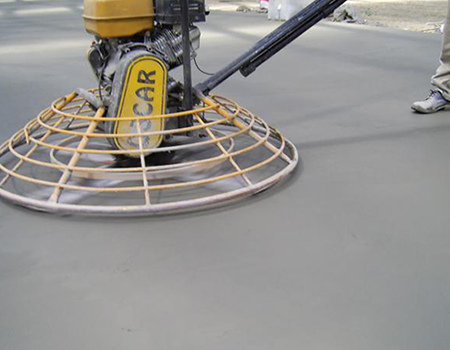
HELICOPTER - MACHINE SCREED APPLICATION
HELICOPTER - MACHINE SCREED APPLICATION

TECHNICAL DATA SHEET
The screed application, which is made by machine and actually referred to as helicopter screed, is generally applied for large and multi-purpose areas. The main feature of this screed application is to obtain a homogeneous, void-free, flat concrete.
Of course, it is also an advantage that the desired level and planar balance can be easily provided in this process. In practice, it can be defined as a propeller connected to a gasoline engine, which is likened to a helicopter, and to which steel trowels are attached at the end.
The reason for using a trowel in this way is that more impacts per unit time and planar equality are provided more easily with circular movements (the machine that is moved on the concrete by the operator). The concrete quality used in the application is selected according to the purpose.
Screed concrete is usually brought to the area with the help of mixers. Before the application, slabs are prepared in the area. Metal box profiles are fixed to the floor to ensure the level and flatness of the concrete. In order to prevent cracking in the screed over time, it is recommended to apply iron-mesh before concrete application.
This increases the strength of the screed in all respects. Fiber can be used to provide internal reinforcement in the concrete that comes with the help of the mixer. The fiber is thoroughly mixed into the concrete on a scale while the concrete is still in the mixer. The concrete poured on the surface area is first distributed using a gauge, the slabs are removed and machine application is started.
Surface hardeners are used, especially depending on the usage of the surface, as the machine partially works and closes the concrete to the surface. The way of use is to sprinkle the surface hardener on the concrete while the helicopter is working, that is, while it is hovering on the concrete. These hardeners have been diversified to increase the resistance against pressure, load, etc. that the surface will be exposed to.
During the necessary feasibility study, it is decided which of these varieties will be used. For example, quartz and magnetite aggregate surface hardener is used for floors that will be exposed to light traffic, corondum-quartz and magnetite aggregates are used for light and medium traffic loads, and corondum-aggregate surface hardener is used for heavy traffic loads. Helicopter screed work, which can also be seen as a specific application, must be done by a smooth, professional and skilled operator so that the surface hardener can be consumed at an average of 5 kg./m².
At the end of all these works, the concrete, which reaches the desired consistency, reaches a walkable strength. At this stage, the concrete starts to lose water rapidly by reacting, which is called dehydration. This situation causes cracks in the concrete, which are called ant tracks, although precautions have been taken.
Dehydration (rapid water loss) can be solved by applying a solvent-based resin-based curing liquid, which is called curing, on the concrete that has not yet fully set. At the end of all these processes, the necessary grids are made and the joints are cut in order to create an artificial path to the cracks in the concrete. The cut joint gaps are sealed with mastic depending on the cutting width.
